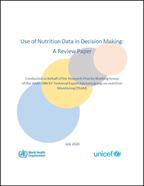Technical reports
National nutrition information systems: modules 1–5
A national nutrition information system (NNIS) is a system for collecting, analyzing, storing, and disseminating nutrition information in a country. Routine...
Indicators for assessing infant and young child feeding practices: definitions and measurement methods...
This document presents a set of new and updated indicators to assess infant and young child feeding (IYCF) practices at household level. It is a follow-up...

Recommendations for data collection, analysis and reporting on anthropometric indicators in children...
In 2016, the WHO-UNICEF Technical Expert Advisory Group on Nutrition Monitoring (TEAM) set up a working group (WG) to establish a set of recommendations...
Global nutrition monitoring framework: operational guidance for tracking progress in meeting targets...
In 2012, the World Health Assembly (WHA) approved a Comprehensive Implementation Plan on Maternal, Infant and Young Child Nutrition that identified six...
Methodology for monitoring progress towards the global nutrition targets for 2025: technical report
As part of the WHO and UNICEF collaboration in global monitoring and reporting on nutrition indicators, the joint WHO-UNICEF Technical Expert Advisory...
Other publications

TEAM Strategic Plan 2022-2027
In 2015, WHO and UNICEF established the independent Technical Expert Advisory group on nutrition Monitoring (TEAM) to advise on global nutrition monitoring....

Nutrition programmes are more successful when they are designed based on robust evidence and knowledge, implemented through multisectoral collaboration,...
Landscape assessment on global monitoring of diet quality: conducted on behalf of the diet quality working...
Diet related risk factors are the leading cause of poor health and mortality. Therefore, it is important to understand diet quality and to monitor it globally....
Improving antenatal iron-containing supplementation indicators: a report on key informant interviews,...
Antenatal iron supplementation coverage is a core process indicator of the Global Nutrition Monitoring Framework (GNMF). WHO-UNICEF’s Technical Expert...

Developing and validating an iron and folic acid supplementation indicator for tracking progress towards...
Antenatal iron-folic acid (IFA) supplementation coverage is a core process indicator of the Global Nutrition Monitoring Framework (GNMF). This indicator...
Events
All →Meeting reports
All →
Healthy Diets Metrics: Technical expert meeting on harmonizing and mainstreaming measurement of healthy...
With rapidly changing diets, the burden of disease due to consumption of unhealthy diets is a worldwide concern. Assessment and monitoring of diets across...

The Thirteenth Meeting of the WHO-UNICEF Technical Expert Advisory group on nutrition Monitoring (TEAM)
In 2015, WHO and UNICEF established an independent Technical Expert Advisory group on nutrition Monitoring (TEAM) to advise on enhancing nutrition monitoring...

The Twelfth Meeting of the WHO-UNICEF Technical Expert Advisory group on nutrition Monitoring (TEAM)
This report provides a summary of discussions, recommendations and decisions emanating from the twelfth meeting of the Technical Expert Advisory Group...

The Eleventh Meeting of the WHO-UNICEF Technical Expert Advisory group on nutrition Monitoring (TEAM)
In 2015, WHO and UNICEF established an independent Technical Expert Advisory group on nutrition Monitoring (TEAM) to advise on enhancing nutrition monitoring...
Technical consultation reports
Report of the technical consultation on measuring healthy diets: concepts, methods...

Joint consultation on approaches to measure coverage of nutrition counselling interventions
This joint consultation was organized by Alive & Thrive and Data for Decisions to Expand Nutrition Transformation (DataDENT) with the WHO-UNICEF Technical...

In 2008, an interagency group developed recommendations on “Indicators for Assessing Infant and Young Child Feeding (IYCF) Practices.” The...

Reconsidering, refining, and extending the World Health Organization Infant and Young Child Feeding Indicators
The global Infant and Young Child Feeding (IYCF) Indicators were published in 2008 and related operational guide was introduced in 2010. In the years since...

